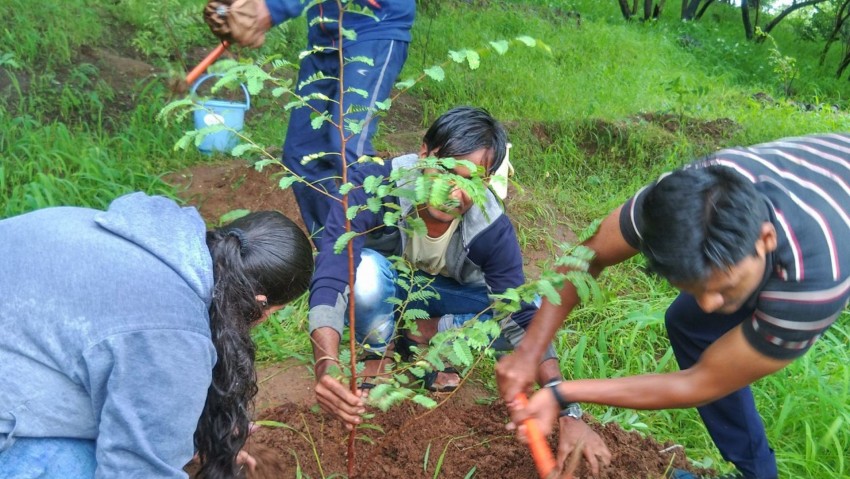Most trees experience shock after transplanting because of the disturbance to the root system. In balled and burlapped transplants, it is estimated that 4 to 9 percent of the original root system and about 2 percent of the soil volume occupied by the root system in the nursery is contained in the root ball. Trees try to keep a balance between the above-ground portion of the tree and the root system (Perry 1982). When the amount of the root system is reduced during transplanting, the above-ground portion of the tree is also affected. The tree either is stimulated to regenerate more roots to balance the top, or the top partially dies back, or both so that the shoots and the roots establish equilibrium.
Thus, transplanting success depends primarily on the care of the root system before and after transplanting. For this reason, post-planting tree care as discussed in this fact sheet is extremely important.
Watering
Water is the most critical factor in transplanting success! Keeping the soil moist, but not wet, through watering is the best avenue to ensure survival and growth of your transplanted tree. Different species of trees and different soils make a general, overall watering recommendation unrealistic. When watering a tree, apply enough to thoroughly soak the soil in the root zone. Transplanted trees require more water than they did in the nursery. Frequent watering of transplants provides more benefit than applying large volumes of water infrequently because of the smaller root system. Drip irrigation systems and water reservoir devices can facilitate watering. Proper water management is the key for establishing transplants quickly.
Mulch
Apply mulch 2 to 3 inches deep on the surface of the planting hole and extending perhaps 2 or more feet beyond the perimeter of the hole. Organic mulch will conserve water in the soil; allow better infiltration of water into the soil during rainfall events or watering and helps to prevent weeds. Do not place mulch against the tree trunk or apply mulch too thickly. Excessive use of mulch can induce fermentation, immobilize nutrients, cut off the oxygen supply and kill trees (Perry 1982).
Size of Planting Hole
The planting hole should be at least 2 or 3 times as wide, and in some cases, where soils are compacted, up to 5 times as wide as the root ball. Wide, shallow holes encourage horizontal root growth by decreasing the resistance for root penetration into the native soil. The larger planting hole and loosened backfill expedites root growth. The sooner the roots are able to penetrate and grow into the native soil, the sooner the tree will become fully established after transplanting.
Score Root Balls
If roots are circling around the root ball exterior, cut through the roots in a few places. Circling roots are usually found in container stock. Cutting helps prevent circling roots from eventually girdling the trunk and also initiates root regeneration and growth that increases the probability that roots will grow from the container medium into the native soil.
Fallacies
Addition of Soil Amendments
Backfill planting holes with existing unamended soil. Do not incorporate organic matter such as peat moss into the backfill. Differences in soil pore sizes will be created, causing problems with water movement, water retention and root growth between the root ball, planting hole and surrounding soil. Backfill half of the planting hole and water thoroughly to settle out air pockets. Water again once back-filling is completed.
Addition of Fertilizer
Research on trees transplanted from field nurseries indicates that there is little benefit to fertilizing at planting (Van de Werken 1981). Since most tree roots are in the upper 12 inches of the soil, trees will receive some benefit when fertilizing turfgrass (Tankersley and Samples 1999). Fertilizer should not be incorporated in the backfill during planting, where it could easily damage exposed tree roots.
Use of Tree Wraps, Shelters and Staking
Tree wraps, tree shelters and tree staking are used frequently to protect trees from external influences. If cared for and maintained properly and regularly, these materials are worthwhile. Experience indicates that treated trees are not usually well maintained at regular intervals and these treatments ultimately are detrimental to the health of trees. In the majority of situations, use of these materials is not recommended unless absolutely necessary. The potential injuries incurred by using these protective measures outweigh their benefits.
Summary
Providing advantageous conditions for tree root growth increases the probabilities of successfully transplanting trees. Proper water management in the first several months after transplanting reduces the stressful establishment period by promoting rapid root growth. Trees that regenerate roots rapidly and establish more quickly will provide many benefits to your landscape.

